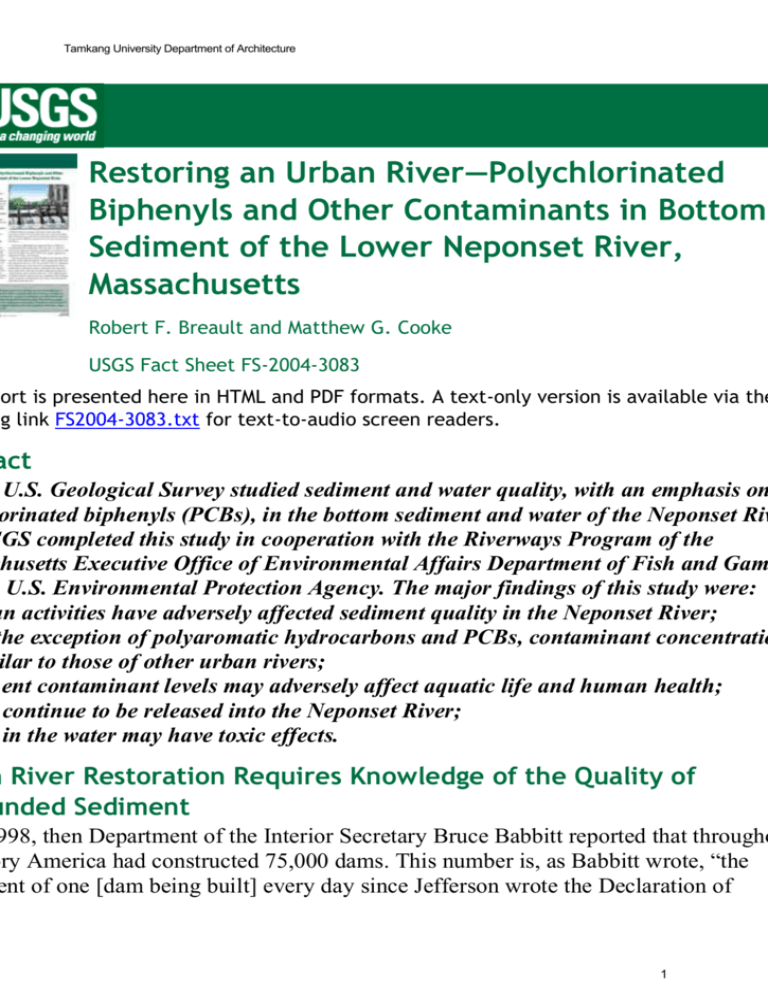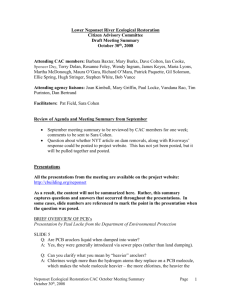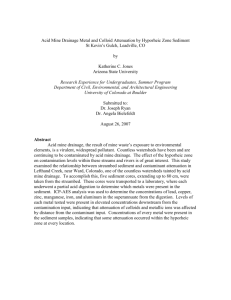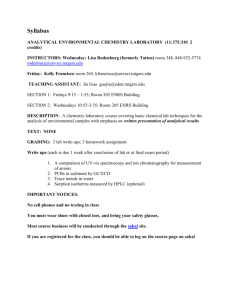Nimi - urbanriver2
advertisement

Tamkang University Department of Architecture Restoring an Urban River—Polychlorinated Biphenyls and Other Contaminants in Bottom Sediment of the Lower Neponset River, Massachusetts Robert F. Breault and Matthew G. Cooke USGS Fact Sheet FS-2004-3083 port is presented here in HTML and PDF formats. A text-only version is available via the ng link FS2004-3083.txt for text-to-audio screen readers. act U.S. Geological Survey studied sediment and water quality, with an emphasis on orinated biphenyls (PCBs), in the bottom sediment and water of the Neponset Riv SGS completed this study in cooperation with the Riverways Program of the chusetts Executive Office of Environmental Affairs Department of Fish and Gam e U.S. Environmental Protection Agency. The major findings of this study were: an activities have adversely affected sediment quality in the Neponset River; the exception of polyaromatic hydrocarbons and PCBs, contaminant concentratio ilar to those of other urban rivers; ment contaminant levels may adversely affect aquatic life and human health; continue to be released into the Neponset River; in the water may have toxic effects. n River Restoration Requires Knowledge of the Quality of unded Sediment 998, then Department of the Interior Secretary Bruce Babbitt reported that througho ory America had constructed 75,000 dams. This number is, as Babbitt wrote, “the ent of one [dam being built] every day since Jefferson wrote the Declaration of 1 Tamkang University Department of Architecture ndence” (Babbitt, 1998). As these dams have aged, many have fallen into states of ir. ms commonly interfere with many natural processes in rivers. Blocking fish passage s the most widely recognized environmental effect of dams, but the reservoirs that reate also inundate wetlands and terrestrial ecosystems; with dams, rivers become nted, and peak flows and other hydrologic characteristics are changed. Dams also sediment regimes in a river by trapping most of the sediment moving downstream dments behind the dams. Baker impoundment, also known as the Lower Mills impoundment. Water from ndment once powered the Walter Baker Chocolate Factory, the first chocolate erica. The original dam was built in 1639 and is considered one of the first dams New World. ms have impounded the Neponset River, a tributary to Boston Harbor, for the past 3 ig. 1). The river historically supported abundant populations of American shad and erring. Presently (2003), the estuary supports an important rainbow smelt fishery. e most urban rivers in the Northeast, the Neponset River also has a long industrial 2 Tamkang University Department of Architecture Dam construction and settlement began as early as 1630. By the mid 1700s, the et River drained one of the most heavily industrialized basins in the Nation. Indust continued on the Neponset River until 1965, when the last major industrial facility ed from the lower section of the river. This industrial past, combined with the ation that continues in the drainage basin, has likely contaminated water, biota, and sediment throughout the river. ch effort by State, local, and Federal agencies has already been put forth towards g the Neponset River and surrounding areas, including the abatement of both al and sanitary discharges, greenway expansion, economic revitalization, and ing access to the river. Although there has been much improvement, work remains e. To that end, environmental managers and local advocates have evaluated riverion efforts, such as channel restoration for aquatic-habitat improvements, and fishe alternatives, including the installation of engineered fishways, dam breaching, and l of the most downstream dams on the lower Neponset River—the Walter Baker Da Tileston and Hollingsworth Dam. Fish passage at these dams would provide access han 17 miles of habitat to shad and herring and help increase recreational use on the Neponset River, that section of the river from Fowl Meadow to the Walter Baker Da on, MA. eased public dialogue about restoration of the Neponset River, combined with river l alteration, the long history of industrialization and urbanization along the river, an nowledge of the occurrence and geographic distribution of sediment contamination ed this study of bottom-sediment quality and quantity. The U.S. Geological Survey ) completed this study in cooperation with the Riverways Program of the 3 Tamkang University Department of Architecture husetts Executive Office of Environmental Affairs (EOEA) Department of Fish and and the U.S. Environmental Protection Agency (USEPA). s fact sheet discusses the prevalence of trace elements and organic compounds in sediment of the Neponset River. Because of the high concentrations of PCBs ed in the river and their high relative toxicities, this fact sheet focuses on the nce, source identification, and toxicity of PCBs in sediment and water of the et River; other bottom-sediment contaminants are also briefly discussed. study described in this fact sheet consisted of the collection of 20 sediment-grab s (from the top 2- 4 in. of sediment), 31 sediment-core samples (composited from 5 depending on the total depth of the sediment), and 12 measurements of PCB trations in the water column by using a passive water-sampling system (PISCES) (f mple-collection design and techniques, laboratory analysis, data-analysis techniques ality-assurance and quality-control procedures are discussed in detail by Breault and 2004). 4 Tamkang University Department of Architecture Sediment-grab (top 2–4 in. of sediment) and sediment-core (5–50 in., depending on the total depth of the sediment) sampling n of passive-water- sampler (PISCES) deployment, in the Neponset River of Massachusetts. 5 Tamkang University Department of Architecture n Activities Have Adversely Affected Sediment Quality in the nset River ce element concentrations measured in sediment samples from the lower Neponset were compared to concentrations from selected New England streams, which for the es of this study represent “nonurban background” concentrations. This comparison hat historical and recent human activities have affected many trace element trations, for example, concentrations of lead, a common contaminant resulting from activities (fig. 2). oncentrations of some trace elements in sediment, such as lead, are not unexpected i ponset River because of the historical and continued use of these trace elements in y and the use of automobiles in the area around the Neponset River. 6 Tamkang University Department of Architecture Figure 2. Lead concentrations measured in sedi samples collected from the Neponset River and me (*) lead concentrations measured in sediment samples collected from the lower Charles and u Mystic Rivers of Massachusetts and other urban r from across the United States. The direct-con exposure-based soil standard and probable effect background concentrations for lead are also shown. ike trace elements, organic compounds do not generally occur naturally in aminated sediment; the detection of an organic contaminant is considered the result activities. Some polyaromatic hydrocarbons (products of incomplete combustion) etected in most of the samples. Some PCBs (manufactured organic compounds) wer tected in most of the samples (fig. 3). Organochlorine pesticides, however, were not 7 Tamkang University Department of Architecture d in the grab samples, but there were many detections of these pesticides in the core s. Most notably, Chlordane, and the pesticides DDT, DDD, and DDE were detected ore samples. The detection of these compounds in many core samples and not in an nt-grab samples is expected. Because the use and disposal of these organic compou ore prevalent in the past than in recent years, the products from past uses are buried iment. The general use of DDT was banned in the United States in 1972. In 1988, th A banned all uses of Chlordane. 8 Tamkang University Department of Architecture Figure 3. Total PCB concentrations measur sediment samples collected from the Nep River and median (*) total PCB concentra measured in sediment-grab samples colle from the lower Charles and upper Mystic R of Massachusetts and other urban rivers across the United States. The range of concentrations measured in a sediment samples collected from Woods Pond, the impound- ment downstream of a heavily contaminated area on the Housatonic R Massachusetts, probable effect concentra and the direct-contact, exposure-based standard for PCBs are also shown. 9 Tamkang University Department of Architecture the Exception of PAHs and PCBs, Contaminant Concentrations milar to Those of Other Urban Rivers b-sample data were compared with data from other urban rivers throughout the Uni Rice, 1999); the data were also compared with data from the lower Charles (Breaul ers, 2000) and upper Mystic Rivers (Breault, unpublished data), two other urban ies to Boston Harbor. Sediment-core PCB data were also compared to data from the onic River, a river in western Massachusetts with known PCB contamination (Unite Environmental Protection Agency, 2003). centrations of trace elements, like lead, in grab samples from the Neponset River ar ly equal to or less than concentrations in sediment collected from other urbanized, wing rivers (Rice, 1999; fig. 2). In contrast, organic compound concentrations, arly PAHs and PCBs, are much higher in grab samples from the Neponset River. F e, median PCB concentrations measured in grab samples from the Neponset River a han 125 times greater than those median concentrations in sediment samples from vers across the United States (Rice, 1999). erally, concentrations of many contaminants in sediment are lower in the Neponset han they are in either the Charles or the Mystic Rivers. In contrast, concentrations o n sediment in the Neponset are similar to those in the Charles and greater than those stic River. Some parts of the Neponset River are highly contaminated with PCBs, arly within current impoundments and former impounded areas (fig. 3). assess the contamination severity, it is useful to compare PCB concentrations ed in sediment cores collected from current impoundments and former impounded 10 Tamkang University Department of Architecture f the Neponset River to concentrations in sediment samples collected from the onic River (fig. 3). Although concentrations are higher in the Housatonic River than n the Neponset River, concentrations in sediments of the first impoundment (Woods downstream of the heavily contaminated area in the Housatonic River are comparab oncentrations in the sediments of the Tileston and Hollingsworth impoundment in t et River (U.S. Environmental Protection Agency, 2003). ment Contaminant Levels May Adversely Affect Human Health a tic Life er-restoration efforts often focus on bringing people and river together. When a rive d, access to it improves, recreational opportunities increase, and more people fish, and boat in the river. As people interact with the river, they will likely come in cont diment. ation about human health risks associated with contaminated sediment would allow esource managers to plan their river-restoration efforts. Potential human health effe indirectly assessed by comparing sediment-contaminant concentrations with exposu uidelines. These guidelines, however, do not exist for aquatic sediment, but they do r contaminated upland soil (Massachusetts Department of Environmental Protection standards exist for many of the constituents tested; but in the sediment samples, on f the constituents were detected at concentrations near or above the soil standard. mportantly, however, PCBs and some PAHs, when considered in relation to the dire , exposure-based soil standards, may represent the greatest human health risk in the et River (fig. 3). By comparing contaminant concentrations to sediment quality nes, known as probable effects concentrations, sediment quality is quantifiable in f potential adverse biological effects to benthic organisms, which live and feed in th 11 Tamkang University Department of Architecture ottom and are an important food source for much of the other life in the river (Inger ers, 2000). The average estimated toxicity potential to benthic organisms ranged fro 5 percent to 80 percent among the grab samples (fig. 4). For example, a single nt sample with an estimated potential toxicity of 15 percent indicates that 15 out of icity tests on that single sample likely will show toxicity. In this study, trace metals H saccounted for some potential toxicity. More importantly, PCBs were most ible for predicted toxicity (Ingersoll and others, 2000). Figure 4. Estimated average potential toxicity fo top 2–4 in. of bottom sediment collected from Neponset River. For example, a sediment sample an estimated potential toxicity of 15 percent m that 15 out of 100 toxicity tests are likely to some level of toxicity for the contam concentrations measured in that sediment sample Continue to be Released into the Neponset River CES samplers, deployed in the water column, absorb PCBs from the water across a rmeable membrane into a sample of hexane, in which they dissolve and accumulate analysis shows a characteristic pattern of individual PCB compounds, known as ers, which can be characteristic of a PCB source, in the same way that fingerprints to an individual. The degree of difference between these patterns in samples collect djacent sampling locations can be analyzed with a statistic known as the root mean 12 Tamkang University Department of Architecture difference (RMSD). Statistically, different RMSD values indicate a measurable nce in congener pattern between sampling locations and thus potentially different PC (Breault and others, 2004). most likely source of dissolved PCBs to the Neponset River, as indicated from S data, is bottom sediment downstream from Fairmont Avenue. This PCB inated sediment was likely transported from a historic source and deposited in this the river. The point of maximum change in PCB congener pattern measured in bott nt coincides with that of the PISCES samples (fig. 5). These data are consistent with source located just upstream from Fairmont Avenue. Alternatively, the change in er pattern could be caused by anaerobic degredation of the historic PCB ination in the depositional zone in that part of the river. In this case, the historic would be located farther upstream (Breault and others, 2004). Figure 5. Mean PCB concentration measured in pas water samplers (PISCES) and the degree of the chan PCB congener pattern (or fingerprint) along Neponset River—as indicated by the statistic root m square difference (RMSD). The most likely source of to the Neponset River is somewhere between the M Shell and Fairmont Avenue sampling location between Reservation Park and Fairmont Avenue. in the Water May Have Toxic Effects ause PCBs affect fish, wildlife, and human health, environmental management s, including the USEPA, set maximum acceptable values for PCBs in water. The acceptable value for PCB concentrations in freshwater is 14.0 parts per trillion (ppt 13 Tamkang University Department of Architecture CES sample data indicate that PCB concentrations in Mother Brook (average ed PCB concentration equal to 1.2 ppt) or in the Neponset River upstream of Fairm e (2.8 ppt) would not be expected to cause adverse biological effects. On the other xposure to PCBs downstream of the Fairmont Avenue sampling location (66 ppt) m ly affect aquatic organisms or wildlife (fig. 6). Figure 6. Concentrations of PCBs dissolved in the w estimated from duplicate PISCES samplers at location. Water concentrations increase sh downstream of the Fairmont Avenue PISCES sam location and generally decrease downstream of location. Estimated concentrations of PCBs dissolv the water downstream (left to right) of the Fair Avenue PISCES sampling location exceed the U.S. ronmental Protections Agency’s (USEPA) freshw concentration limit (continuous chronic criterion PCBs dissolved in water. hough PCB concentrations in aquatic organisms were not directly measured, they w ed from the PISCES data (Breault and others, 2004). Average PCB concentrations i ry-fish fillets (edible fish parts) were estimated to range from about 0.04 parts per (ppm) to 0.3 ppm upstream of the Fairmont Avenue sampling location and to be .9 ppm downstream of the sampling location. These concentrations are similar to measured by the Massachusetts Department of Environmental Protection (MDEP) in Massachusetts Department of Environmental Protection, 1994). On the basis of the findings, the Massachusetts Department of Public Health issued a fish-consumption y for brown bullhead collected from the Neponset River between the Hollingsworth se Dam (Walpole, MA) and the Tileston and Hollingsworth Dam (Hyde Park, MA) organic compound dioxin is among the most toxic of substances found in the ment. Of the 209 PCB congeners, 13 are considered dioxin-like; that is, they cause 14 Tamkang University Department of Architecture fects similar to those caused by dioxin. Because of this similarity, the toxicity of th ers can be assessed in relation to the toxicity of dioxin. This assessment is referred c equivalency (TEQ). mated PCB water-column concentrations in the Neponset River, when expressed in f TEQ, were generally near or slightly greater than the USEPA human- health d for dioxin (0.000005 ppt), except for the sample from the Incinerator Road locatio gest total TEQ was calculated for the samples collected just downstream of the n and Hollingsworth Dam. At this sampling location, the TEQ was estimated to be 0 times greater than the standard. ment-Quality Data Support Future River-Restoration Decisions data presented here will help environmental managers evaluate the advantages and ons of fish-passage alternatives and sediment-management options. Possible option dredging and removal of contaminated sediment, channel restoration with ation of contaminated sediment, and breaching and removal of dams allowing for bution of contaminated sediment downstream. Knowledge of existing concentration tribution patterns of contaminants in the river will help guide the selection of the m ective and environmentally beneficial river- restoration strategies. Restoration of th Neponset River will preserve this valuable resource and ultimately contribute to the on of the Neponset River Estuary and Boston Harbor. 15 Tamkang University Department of Architecture ability port is presented in Portable Document Format (PDF). To view and print report you wil have PDF Viewer or Adobe Acrobat Reader (available as freeware). Users with visual ties can click here for conversion tools and information to help make PDF files more ble sible text version FS2004-3083.txt (21 KB) ble PDF version FS2004-3083.pdf (10,7 MB) -- 6 pages ation for this report, in USGS format, is as follows: F., Cooke, M.G., Restoring an Urban River—Polychlorinated Biphenyls and Other Contaminants in Bottom Sediment of the onset River, Massachusetts, FS-2004-3083, 6 p. 16 Tamkang University Department of Architecture e information about USGS activities in Massachusetts-Rhode Island District, visit the U husetts-Rhode Island Home Page Fact Sheets Home Page Environment Hazards Information Resources State Management AccessibilityFOIAPrivacyPolicies and Notices U.S. Department of the Interior, U.S. Geological Survey Persistent URL: http://pubs.water.usgs.gov/fs20043083 Page Contact Information: USGS Publishing Network Last modified: Monday, December 12 2005, 10:08:02 AM 17







